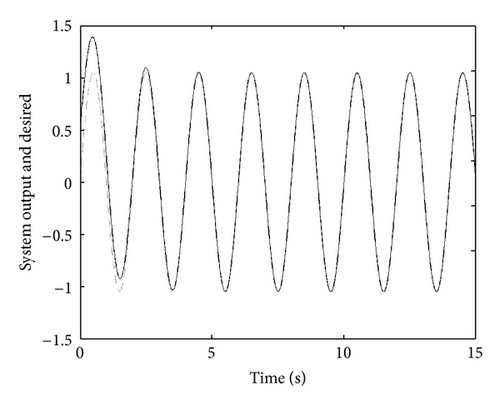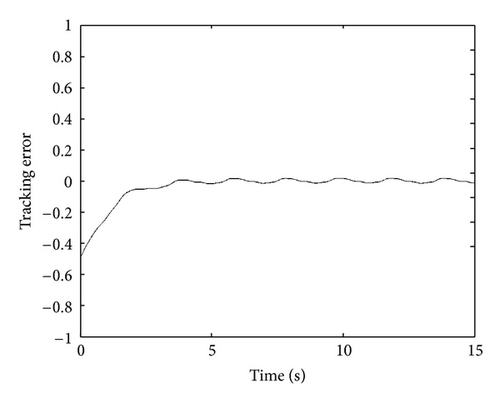Optimal Robust Adaptive Fuzzy H∞ Tracking Control without Reaching Phase for Nonlinear System
Abstract
An optimal H∞ tracking-based indirect adaptive fuzzy controller for a class of perturbed uncertain affine nonlinear systems without reaching phase is being developed in this paper. First a practical Interval Type-2 (IT2) fuzzy system is used in an adaptive scheme to approximate the system using a nonlinear model and to determine the optimal value of the H∞ gain control. Secondly, to eliminate the trade-off between H∞ tracking performance and high gain at the control input, a modified output tracking error has been used. The stability is ensured through Lyapunov synthesis and the effectiveness of the proposed method is proved and the simulation is also given to illustrate the superiority of the proposed approach.
1. Introduction
After the approximation-based adaptive fuzzy controller (AFC) of Wang [1] for a class of uncertain affine nonlinear system, many approaches and ideas have been developed in recent years to overcome the difficulty in controller design [2–4].
The primary feature that characterizes the fuzzy logic is its high capacity for representing and modelling the nonlinear systems with imprecise uncertainty, as the universal approximation theorem, by Lee and Tomizuka, illustrates [5].
Many effective adaptive fuzzy control schemes have been developed to incorporate with human expert knowledge and information in a systematic way, which can also guarantee various stability and performance [6]. The most important issue for Fuzzy Logic Systems (FLSs) is how to get a system design with the guarantee of stability and control performance [7–9].
An adaptive fuzzy control system includes uncertainties caused by unmodeled dynamics, Fuzzy Approximation Errors (FAEs), and external disturbance, which cannot be effectively handled by the FLS and may degrade the tracking performance of the closed-loop system [10, 11]. The AFC combined with H∞ control technique is an effective approach for rejecting those uncertainties, ensuring stability and consistent performance [12–14].
The research of fuzzy model under H∞ has attracted many attentions in recent years [4, 15], such as the apparent similarities between H∞ and fuzzy control which motivate considerable research efforts in combining the two approaches for achieving more superior performance.
Moreover, to the best of our knowledge, the control gain needs to be known in all previous H∞, indirect adaptive fuzzy controller (HIAFC) approaches, such as the arbitrary choice of the gain which does not always give good results, for which we propose in this work a method for extracting automatically the optimum gain from the Lyapunov equation whilst respecting system stability.
The convergence of the system in the initial time needs the appearance of high gain at the control input, and the high gain is unavoidable in all previous H∞ tracking-based AFC approaches. The best method to solve the problem of the tradeoffs between H∞ tracking performance and high gain at the control input is to eliminate the reaching phase. During the reaching phase the tracking error cannot be controlled directly and the system response is sensitive to parameter uncertainties. Several methods have been proposed to completely eliminate the reaching phase [16].
This paper focuses on a class of Single-Input Single-Output (SISO) perturbed uncertain affine nonlinear systems involving external disturbances without exact knowledge of dynamic functions. Firstly, we use the type-2 fuzzy technique to determine the optimal value of the H∞ gain control. Secondly, a modified output tracking error is used to eliminate the reaching phase [4].
The paper is organized as follows: Section 2 presents the problem statement. Section 3 gives the control design strategy. An illustration example is described in Section 4. Finally, the simulation results are being used to demonstrate the effectiveness and performance of the proposed approach.
2. Problem Formulations
Assumption 1. For all , there exist unknown bounded , and such that , and hold, where compact set D ⊂ Rn is a certain controllable region.
During the AFC design, to improve the tracking performance under the external disturbance, an additional H∞ compensator associated with an attenuation level is usually suggested to apply, Chen et al. [14]. If the prescribed attenuation level is smaller, the tracking performance is better while the control input gain is higher as the output of the H∞ compensator becomes larger.
To avoid high control input gain, we have modified the following output tracking error Yilmaz and Hurmuzlu [16]:
A suggested ψ(t) is given in the following exponential form:
Now, the objective of this paper is to determine the optimal value of the H∞ gain control, in a way to force y(t) to follow a given bounded reference signal yr(t).
Let us denote the parameter tracking error for some parameter estimate and optimal parameter estimate of Type-2 Fuzzy Logic System (T2FLS). Let w denote the sum of error due to fuzzy modelling approximations. Then our design objective is to impose an adaptive fuzzy control algorithm so that the following asymptotically stable tracking
Q, V, and w will be defined in the next subsection.
Remark 2. (i) The roots of polynomial in the characteristic equation of (6) are all in the open left-half plane via an adequate choice of coefficients k0, k1, …, kn−1.
(ii) If the system starts with initial condition V(0) = 0, then the H∞ performance in (7) can be rewritten as
3. Control Design Strategy
3.1. Indirect Adaptive Control Scheme
In this section, we propose a new optimal H∞ tracking-based indirect adaptive output-feedback fuzzy controller that eliminates the reaching phase, with guaranteed stability of the closed loop system. Based on the combination of the H∞ optimal control with fuzzy logic control, using fuzzy identifier and fuzzy logic control, the H∞ control design relies on the solution of an algebraic Riccati equation.
, , and are the type-2 fuzzy approximation of ,, and ℜ.
3.2. Interval Type-2 Fuzzy Logic System (IT2FLS)
The previous equation (18) will be used, in an indirect adaptive control, to approximate the unknown system dynamics and to determine the optimal H∞ gain control.
3.3. H∞ Tracking Performance Design in Indirect Adaptive Fuzzy System
Theorem 3. If we select the following adaptive fuzzy control law in the nonlinear system (1)
Proof. We have
Utilising (3) and substituting (30) into (31), the output error dynamics may be expressed as
The error dynamics can be represented by
Consider the following Lyapunov function:
4. An Illustrative Example
4.1. The Dynamic Model
We assume that the position x1 and the velocity x2 are available for measurements, where m = 2 kg, l = 1 m, gv = 9.8 m/s2, and df = 1.0 kg m2/s.
4.2. Controller Parameters Design
Step 1. In the first step, we need to define the type-2 fuzzy sets for modelling the unknown functions entering into the creation of the control law and to determine the optimal value of the H∞ gain control. The choice of the number of fuzzy sets and constant Mf, Mg, and Mℜ are related to knowledge of expert on the system.
Step 2. Determine parameters of the modified error E in (3).
Choose α = 5 in (5).
To determine γ(t) in (4) one can follow the method in Yilmaz and Hurmuzlu, and one can make
Step 3. Design parameters of the control law.
The control parameters for simulation are chosen as follows: k0 = 1, k1 = 2, γ1 = 0.002, γ2 = 0.0001, γ3 = 0.001, Q = 5 eye (2), and ρ = 0.1.
The solution to Riccati equation for Q is
4.3. Simulation Result
Simulation result is presented to validate performance and robustness of the proposed approaching that we have been using T-S fuzzy logic to determine automatically the gain of the H∞ control and modifying the output tracking error to eliminate the reaching phase.
Three fuzzy sets for each input have been found sufficient for an efficient system design. Fuzzy sets for inputs x1 and x2 are defined according to the membership functions presented forward in Step 1.
The sampling time is defined as 10 ms and the running time as 15 s.
Figure 1 present a responses of the output y(t) versus the desired output yr(t).

Figures 2 and 3 present successively the tracking error and the control signal that we apply the proposed method.


5. Conclusions
In this paper, we have proposed a new method to determine the optimal value of the H∞ gain control based on type-2 fuzzy logic systems, and to eliminate the trade-off between H∞ tracking performance and high gain at the control input, we have used the modification in the output tracking error.
The parameters of the dynamics systems are estimated by using the fuzzy model. Furthermore, the parameters can be tuned on-line by the adaptive law based on Lyapunov synthesis.




